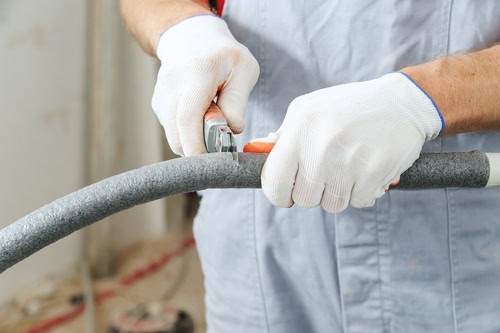Making Use of Inappropriate Insulation:
Choosing the wrong insulating material is one of the most frequent errors. Materials with appropriate thermal resistance are necessary for air conditioning systems in order to reduce energy loss. Inefficiency, condensation, and heat transfer can result from using subpar or unrecommended materials. For instance, because fibreglass insulation deteriorates with time and absorbs moisture, it may not be appropriate for outdoor piping.
- How to Prevent: Always use closed-cell foam insulation since it offers superior heat resistance and moisture resistance. To be sure it will work with the specifications of your system, check industry standards or manufacturer recommendations.
Not Enough Insulation Thickness:
Although choosing thinner insulation may result in short-term cost savings, system performance is eventually compromised. Heat gain or loss due to inadequate thickness might make it more difficult for the air conditioner to maintain the desired temperatures. This reduces the system’s longevity in addition to increasing energy usage.
- How to Avoid: Depending on the pipe size and application, calculate the proper insulation thickness by adhering to industry standards and local building rules. For instance, exterior pipes exposed to colder climes or direct sunlight need stronger insulation.
Inadequate Methods of Installation:
The finest insulation material won’t make up for shoddy installation. Misaligned joints, sloppy wrapping, and insulating gaps are common mistakes. These errors impair the benefit of insulation by permitting moisture intrusion or heat transfer.
- Avoid: Train employees on correct installation methods or hire qualified technicians. To close gaps and secure the insulation, use sealants and adhesive tapes. Make certain that every joint and seam is lined up and securely fastened.
Ignoring Valves and Pipe Fittings:
Bends, valves and pipe fittings are frequently disregarded when installing insulation. If not adequately insulated, these spaces are vulnerable to heat transfer and condensation, which could result in water damage and energy losses.
- How to Avoid: For these components, use custom-fit insulation or prefabricated insulation covers. Make sure these components are sealed to the same standard as the main piping with special care.
Outdoor Piping Is Not UV Protected:
Sunlight exposes outdoor air conditioning pipes, and UV rays cause many insulating materials to deteriorate. Insulation may peel, break, or lose its thermal resistance as a result of UV degradation over time.
- How to Prevent: For outdoor installations, utilize insulating materials with integrated UV protection or apply a UV-resistant protective coating. For extra durability, you can also cover the insulation with PVC or metal jackets. Examine outdoor pipes on a regular basis to spot and fix any UV damage.
Skipping Vapor Barriers:
Ignoring a vapour barrier can cause condensation to accumulate inside the insulation in humid conditions. This moisture has the potential to erode insulation over time, resulting in pipe corrosion or the growth of mould.
- Avoid: Use insulation that has a vapour barrier built in at all times, or install a separate barrier during installation. To stop moisture intrusion, make sure the vapour barrier’s joints and seams are adequately sealed.
Not Keeping Insulation Up:
If not maintained, even premium insulation can deteriorate over time. Wear and tear, rat or bird damage, and exposure to adverse environmental conditions are common problems. Costly repairs and energy inefficiency can arise from neglecting maintenance.
- Ways to Prevent: Establish a routine maintenance program to check the insulation in the air conditioning pipes. Damaged sections should be replaced or repaired right away. To reduce exposure to environmental elements, think about enclosing exterior pipes with protective coverings.
Ignoring Fire Safety Regulations:
There is a risk in the event of a fire because some insulating materials might not adhere to fire safety regulations. This error frequently occurs when non-fire-retardant materials are used as a result of cost-cutting tactics.
- How to Prevent: Always select insulating materials that adhere to local fire safety regulations and requirements. Seek out goods with fire-retardant qualities and make sure the installation complies with building codes.
Applying Adhesives Not Correctly:
Insulation must be secured with adhesives, but if they are applied incorrectly, the insulation may become loose or misaligned. Using the incorrect glue, applying too little, or not allowing enough time for drying are common mistakes.
- How to Avoid: Use adhesives that are compatible with the insulation material and recommended by the manufacturer. To guarantee a strong bond, uniformly apply the adhesive and adhere to the curing guidelines.
Frequently Asked Questions:
1. How Does Refrigerant Recycling Operate?
The process of collecting, cleaning, and reusing refrigerant from an existing system is known as refrigerant recycling. This procedure minimises the impact on the environment and lessens the requirement for additional refrigerants. To guarantee that the recovered refrigerant satisfies quality standards, impurities are removed using specialised equipment.
2. Why Does Pipe Installation Require Nitrogen?
When installing pipes, nitrogen is used to remove moisture and oxygen from the system, which can lead to contamination and corrosion. It is also utilised to pressure test the pipes, guaranteeing they are leak-free prior to refrigerant filling. This technique is important for preserving system safety and performance.
3. What Dangers Come with Do-It-Yourself Refrigerant Piping Repairs?
Inappropriate connections, leaks, or system damage can result from do-it-yourself refrigerant piping repairs. There is also a chance of breaking environmental laws pertaining to the handling of refrigerants if the right equipment and knowledge are not available. Expert technicians guarantee system performance, safety, and compliance.
4. How Do Refrigerant Systems Benefit from Inverter Air Conditioners?
By adjusting compressor speed in response to cooling demand, inverter air conditioners maintain constant temperatures while using less energy. By keeping pressure levels constant, they also lessen the strain on refrigerant pipes, extending the system’s longevity. Compared to non-inverter types, these systems are more ecologically friendly and efficient. 11. How Are Refrigerant Pipelines Protected by Pressure Switches? Refrigerant pressure levels are monitored by pressure switches.


